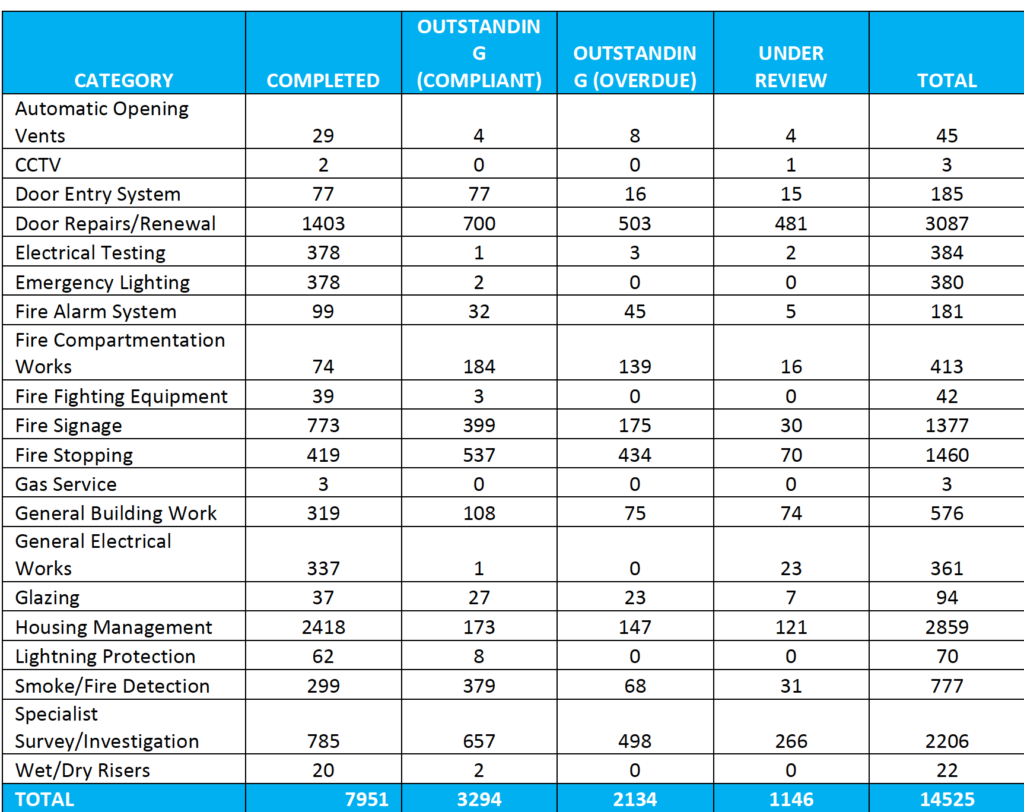LBWF launches a £40m. programme to upgrade the fire safety of its social housing provision, but questions remain as to why this wasn’t done years ago
It has long been suspected, by this blog not least, that LBWF is facing a major problem about fire safety in its social housing provision, and now some new evidence shows that not only is this true, but something is finally being done about it.
The pandemic has slowed down council reporting across the board, and so for the latest developments it is necessary to go back to a report presented by Divisional Director Housing Assets, Sumitra Gomer, at the Audit and Governance Committee meeting in January of the present year.
This makes sobering reading.
Ms. Gomer estimated that to bring all of LBWF’s housing units up to the standard required would take an astonishing 14,525 separate ‘actions’.
And while she undelined that some of these ‘actions’ already had been completed, there clearly was much still to do. A pair of tables summarised the key data:
Thus, amongst the ‘actions’ yet to be addressed were (a) 50 per cent of those rated ‘high’ or ‘medium’ priority; and (b), in terms of specific issues, more than half of those concerning such important matters as ‘Door Repairs/Renewal’, ‘Fire Compartmentation Works’, ‘Smoke/Fire Detection’, and ‘Specialist Survey/Investigation’.
Subsequently, LBWF has released a few further details about what it presently refers to as a ‘comprehensive programme of works’.
Given the large number of faults that need correcting, it is unsurprising to find that the total cost of what’s planned currently is projected to be £40m. though this sum likely will rise as the remaining property surveys are completed.
Nor is it unexpected to find that LBWF is initially concentrating on its high-rises, particularly Rosewood Court, Gean Court, Mulberry Court, Blackthorn Court, St David’s Court, St Nicholas Court, St Patrick’s Court, St George’s Court, Burrell and Raynor Towers, and Northwood Tower.
Here, LBWF has largely jettisoned its previous ‘Stay Put’ policy in favour of ‘Waking Watch/simultaneous evacuation’ supervised by round the clock fire marshals, the latter costing a further c. £1.8m. p.a..
How on earth has the need for such large-scale intervention come about?
LBWF predictably claims that it is responding to new legislation (either being enacted or proposed), plus more exacting statutory building standards. Post Grenfell, it asserts, all local authorities are having to grasp the same nettle.
This is reasonable, but it is also by no means the whole story.
For the truth is that, as previous posts have shown (see links below), during the past decade LBWF let fire safety slip further and further down the agenda.
Consider the Fire Risk Assessment (FRA) of Northwood Tower that was completed for LBWF in March 2017, that is, more than five years ago.
This rated the risk of fire as ‘High’, and listed a whole series of major faults, such as the following:
It is clear that most of these faults stemmed from poor organisation and implementation, oversights that would be wrong whatever the legislation; while tracing them backwards in time via previous annual FRAs shows that, reprehensibly, the large majority had been noted at least once before, yet left uncorrected.
And, it must be emphasised, the situation at Northwood Tower was far from an exception.
The inescapable conclusion, then, is that well before the present call to arms LBWF was warned that fire safety across much of its estate was problematic, but for the most part chose to sit on its hands.
So while the current fire safety upgrade is to be welcomed, questions remain about the failures of the past.
What’s for sure is that LBWF’s Labour Cabinet emerges with little credit. Previous Council Leaders Chris Robbins and Clare Coghill were fond of claiming that they ‘put local people first’. The current incumbent, Cllr. Grace Williams, who first joined the Cabinet in 2016, now repeats the same mantra.
The contrast between their rhetoric and the tawdry reality is striking, and goes some way to explaining why a growing number of residents wonder whether, as regards fire safety, at least, LBWF ever again can be trusted to do the right thing.







